Report
 }
}
Executive summary
The Chinese government's official "new normal" policy is redefining the country's economy as it manages GDP growth at 6.5% to 7%, shifts focus from manufacturing to services and consumption, and pushes for innovation-led growth over investment-led growth.
In our fifth year of tracking the shopping behavior of Chinese consumers, we detail the distinct effects that these and other major economic shifts are having on brands. Our continuing research has given us a valuable long-term view of purchase activity across 106 FMCG categories in China. As in each of the past four years, we conducted a deep analysis of the 26 categories1 that span the four largest consumer goods sectors: packaged food, beverages, personal care and home care. Combined, these sectors represent 80% of all FMCG purchases. To further test our conclusions, this year we examined the three additional categories of functional drinks, pet food and sanitary protection. Among our findings:
- Annual growth in FMCG value continued to slow across all sectors we studied, recently hitting a five-year low.
- A combined decline in volume and deceleration in price growth led to slower growth in value. The average growth in annual FMCG spending per household slowed significantly to 0.8% in 2015, but different categories show contrasting trends.
Overall, value growth of FMCG sales dropped to 3.5% in 2015, but that figure disguises an important distinction. In many ways, China now operates at two speeds: slow and fast. This situation plays out in product categories, retail channels and the continuing battle between multinational and domestic brands.
Let's first look at product categories. With many manufacturing jobs moving to Bangladesh, Vietnam and other lower-cost countries, brands in categories that traditionally cater to blue-collar workers, such as instant noodles and value beer, are suffering. For example, in 2015 the volume of instant noodles declined by 12.5%; beer by 3.6%. This slow growth is intensified by a decline in the worker population, which peaked in 2012, resulting in more low-income retirees.
By contrast, fast-growth categories include many that are more dependent on white-collar workers and the growing middle class. With the rise of the service sector and its higher-paying jobs, brands in premium categories such as yogurt and pet food—and premium SKUs in most categories—remain robust:
- Value in pet food rose by 11.7% and in yogurt by 20.6%.
- These consumers also boosted their spending in such non-FMCG areas as travel and entertainment.
China's two-speed scenario is evident in household penetration, with penetration rates for brands in most categories leveling off or dropping, while others are rising. Most brands are turning to a proven approach for squeezing growth when penetration plateaus: investing to offer premium products. Eighteen categories show flat or declining penetration and growing premiumization since 2012.
Retail channels in China feel the two-speed scenario, too. In a continuing trend, super and mini markets decelerated from 9.5% to 4% in 2015. Hypermarkets had declining sales, while convenience stores grew by 13.2% across China.
E-commerce maintained its strong momentum, with a growth rate exceeding 35% over the past four years. China remains the world's largest e-commerce market, generating revenues of nearly RMB 4 trillion last year, and online penetration2 continued to increase at a swift pace, reaching to 43% in 2015 from 25% in 2012.
While the growth in overall spending on fast-moving consumer goods in China has fallen over the past five years, the decline has been unevenly spread. Growth has accelerated for some categories and brands, while sales have dropped off for others. Bruno Lannes, a partner with Bain's Consumer Products practice, discusses three trends within the new "two-speed" scenario and how brands can win in this environment.
We have identified three clusters based on their digital penetration trajectory since 2012:
- With high online penetration, baby-related categories and skin care continue to dominate the e-commerce market.
- Chewing gum, fabric softener and most beverage categories achieved a low online penetration rate in 2015; in fact, their online penetration has not grown significantly in the past four years.
- A third cluster of categories, including most personal care, home care and packaged food, achieved a middle level of penetration but high rates of growth. E-commerce retailers and brands spurred online penetration in these categories through aggressive promotion.
Finally, China's two-speed consumer market is playing out in the continuing battle between foreign and local brands. In 2015, local companies continued to gain share over their foreign rivals on an aggregate basis. Local companies grew by 7.8% in the categories we studied, contributing to a 109% share of market growth, while foreign brands declined by 1.4% in 2015. Local brands have a rapid, single-country-focused process for new product development. They can produce new SKUs without the need for "global alignment." Many are led by first- or second-generation entrepreneurs, who typically can make and execute decisions faster than their counterparts in foreign companies. These advantages enable them to adapt quickly to new trends, a critical skill in these more challenging times. They also have embraced e-commerce faster than their foreign competitors.
This year marked a significant shift in geographic growth. Until now, a city's tier was a major factor in the velocity of value growth, but now, growth across all city tiers is moving into the 3% to 5% range. Brands can't assume higher growth rate in lower-tier cities any more. Among Tier-2 cities, for example, a big difference exists between Nanjing and Dalian. On a regional basis, the Southwest grew the fastest, whereas the Northeast and Southeast saw the slowest growth in 2015.
These trends can help FMCG companies not only better understand market directions but also determine which trajectory their brands are on and how to set the right strategy for that trajectory. Even in the two-speed scenario, shoppers display predictable purchase patterns, and brands can outperform rivals by identifying those patterns.
Companies and brands can win by:
- reviewing their cost structure and operating model to increase agility and speed in decision making and execution and, above all, to embrace the ways that digital is disrupting their categories;
- developing digital capabilities and mindsets specifically within their marketing and sales teams and more broadly throughout all functions;
- adapting their route-to-market (RTM) model, in line with the dramatic retail changes and deterioration of distributors' economics caused by the overall market slowdown and online competition, to focus on winning channels while investing selectively in others; and
- continuing their efforts to boost penetration as the key to creating large brands, relying on digital activation as required in addition to in-store activation.
Full report
Two-speed growth trajectories among product categories
Value growth for fast-moving consumer goods (FMCG) in China reached a five-year low of 3.5% in 2015, resulting from a decline in volume growth across all product categories as well as a slowdown in the increase of selling prices. Overall, volume declined 0.9% and average selling price rose only 4.4% in 2015. That figure is more than twice the rate of inflation but a drop from the 5.4% average selling price increase in 2014 (see Figures 1 and 2).
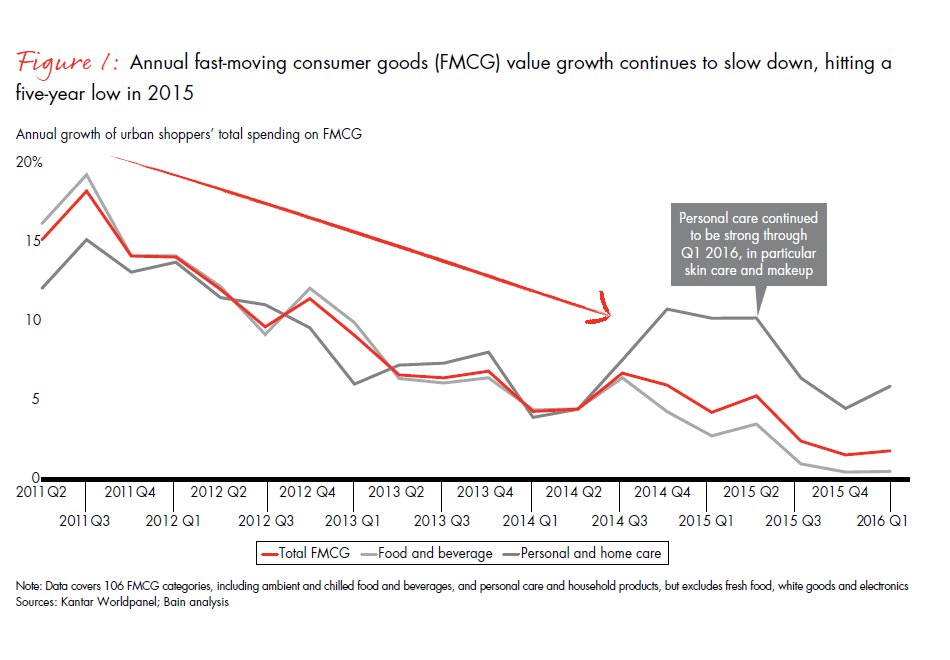
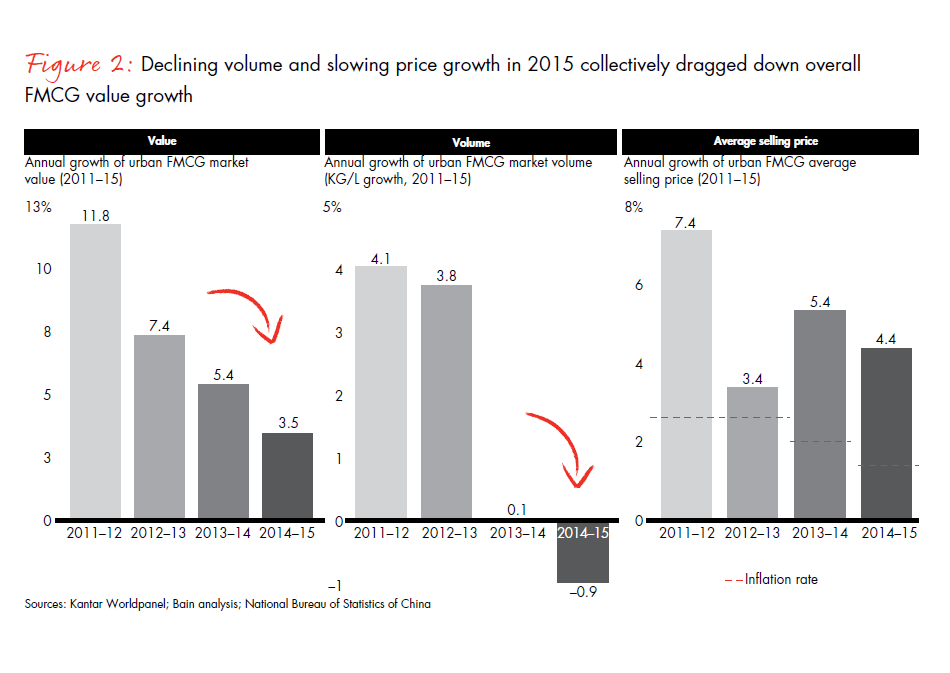
Despite the general malaise, some categories are making significant headway, highlighting how FMCG performance in China now operates at two distinct speeds. For example, makeup grew by 15.5% and skin care by 13.2% in 2015, reflecting rising consumer demand for more complex and premium products in the cosmetic category. Another factor contributing to the uptick in cosmetics: booming online sales of imported cosmetics, which consumers view as more premium than local products.
The performance in the personal care sector tells a compelling story. Volume dropped 1.5% but value rose 9.5%, thanks to premiumization in such categories as makeup. Average prices for personal care jumped 11.1% in 2015, as consumers traded up (see Figure 3). As an example, the value share of imported makeup products is improving steadily, increasing to 34% in 2015 from 31% in 2014 and 28.5% in 2013.
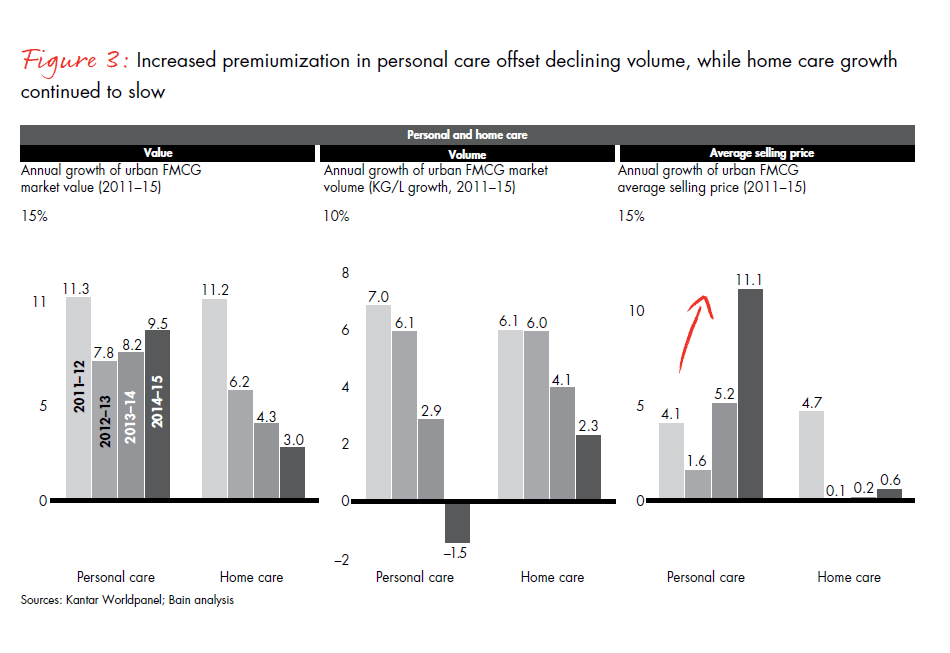
But while skin care and makeup sales soared, packaged food sales dropped 0.4% in 2015. Average prices grew, but only 2%, so the value decline resulted primarily from a drop in sales volume. Even within packaged foods, there was a broad range in performance among categories. For example, the confectionary category’s value sunk 4.5% in 2015, whereas pet food grew a robust 11.7%.
Packaged food’s volume decline is part of a continuing trend; volume dropped 1.1% in 2014 and 2.4% in 2015 (see Figure 4). In some categories, the performance change was dramatic. Instant noodles volume fell by 12.5%, partly because of worsening economic prospects among blue-collar workers and lower-income consumers. Soft cakes and confectionary volumes all decreased by more than 11%, in part because of rising awareness of health issues associated with sweets. At the same time, healthy products performed well, with yogurt growing in value by 20.6% and functional drinks by 6%.
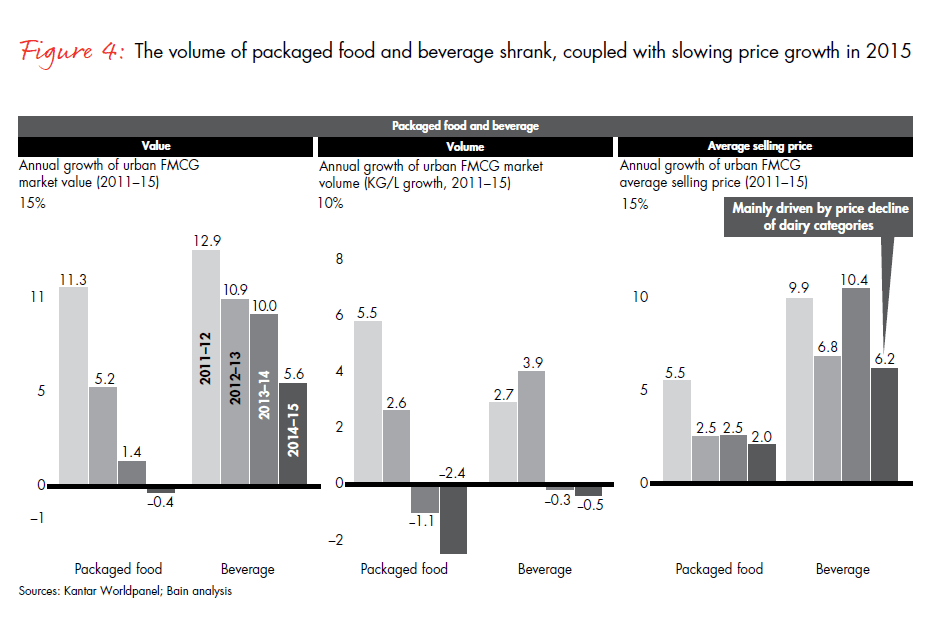
Overall, value growth in beverages fell to 5.6% in 2015, compared with 10% growth in 2014. A number of factors contributed to this slower performance. For one thing, volume dropped for the second year in a row in such categories as beer, juice, ready-to-drink tea and carbonated soft beverages. Also, world dairy prices fell in 2015 because of oversupply, leading China’s prices to sink slightly in 2015 after rising more than 9% a year earlier. Milk prices were dragged down even lower by dairies’ attempts to boost consumption through promotions, which increased 7% in 2015. For example, popular dairy brand Mengniu promoted its Milk Deluxe SKU by offering 17% discounts in some Chinese cities.
In home care products, overall volume growth continued to slow. However, some categories outperformed, with fabric detergent growing 5.9% and paper products (toilet and facial tissues) rising 4.8%. For the third year in a row, the average price in home care did not change much, remaining well below inflation.
What’s behind the general weakening of FMCG sales? It isn’t caused by slowing growth in the number of urban households, which continues to increase steadily (see Figure 5). Instead, it’s the result of a slowdown in average spending per household on FMCG products. FMCG spending grew by only 0.8% in 2015, which is much lower than the growth rate in disposable income (8.2%). Indeed, Chinese shoppers who can afford it are shifting their spending toward non-FMCG products (see Figure 6). With the Chinese economy maturing, FMCG spending as a percentage of total household spending is declining and will approach levels seen in more-developed markets. The country is experiencing double-digit growth in such sectors as health and wellness, lifestyle, travel and entertainment. Consider that from 2011 to 2015, cinema revenues expanded by an average 35.4% annually, international travel by 28% and water purifier sales by more than 50%.
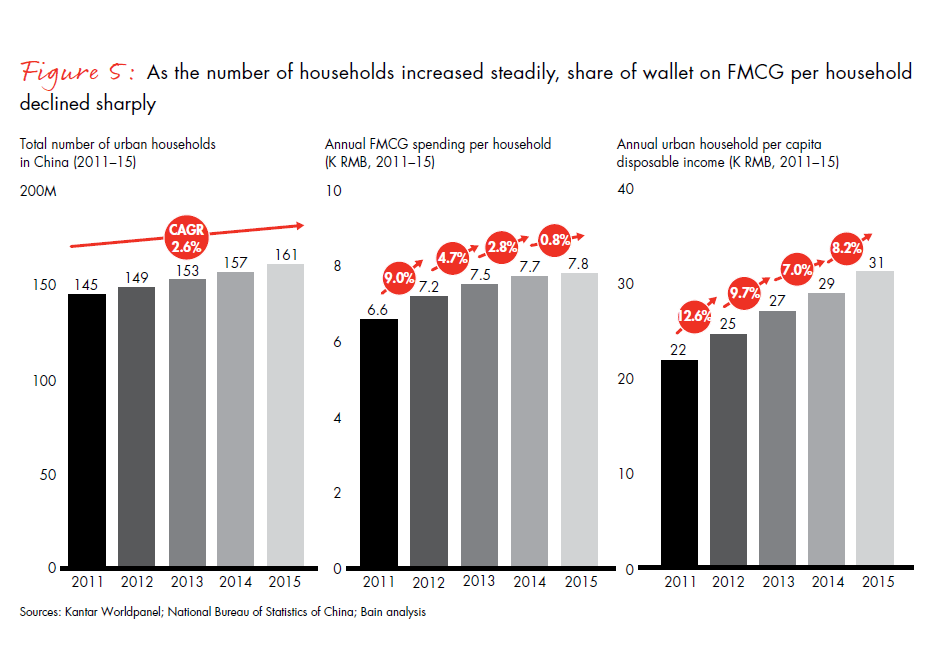
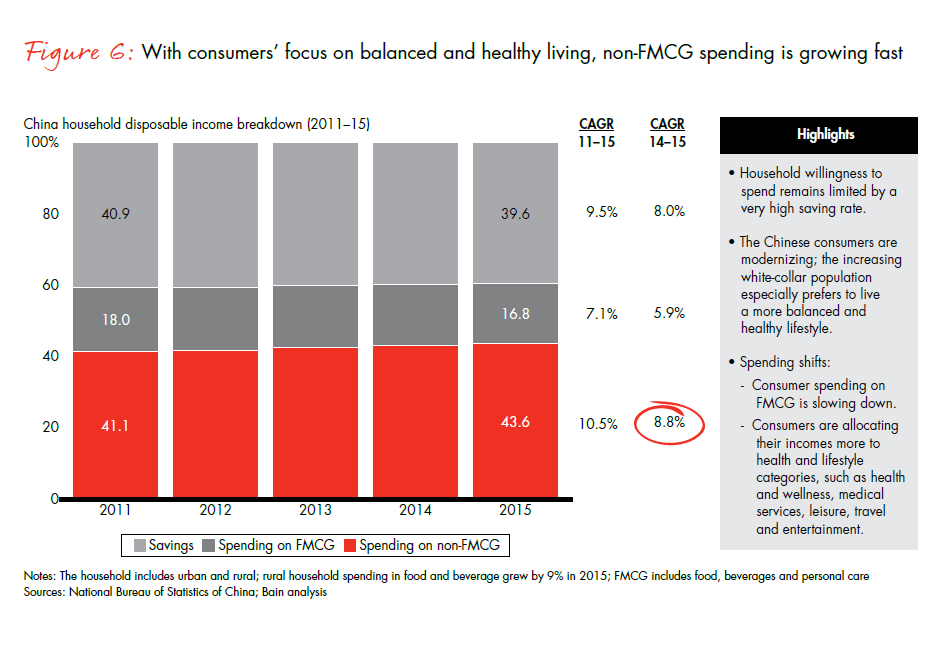
As FMCG sellers adapt to China’s two speeds of growth, they also are adjusting to another reality. In the past, city tier played a big role in growth. Now, growth is evening out, with all city tiers watching FMCG growth settling in the 3% to 5% range (see Figure 7). Brands can’t rely on a city tier to predict growth rates. Consider that among Tier-2 cities, Shenzhen, Nanjing, Hangzhou and Tianjin together grew by 9.2% in 2015, whereas the rest of the Tier-2 cities grew by a mere 2.6%, with Dalian even declining by 0.4%. Among regions, the Southwest grew the fastest while the Northeast and Southeast experienced the slowest growth in 2015 (see Figure 8).
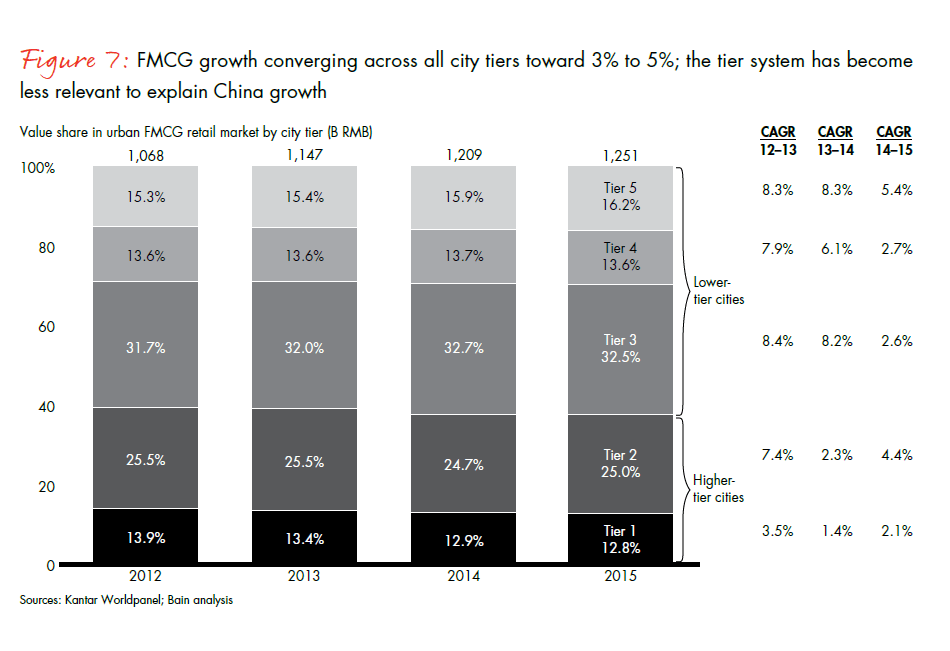
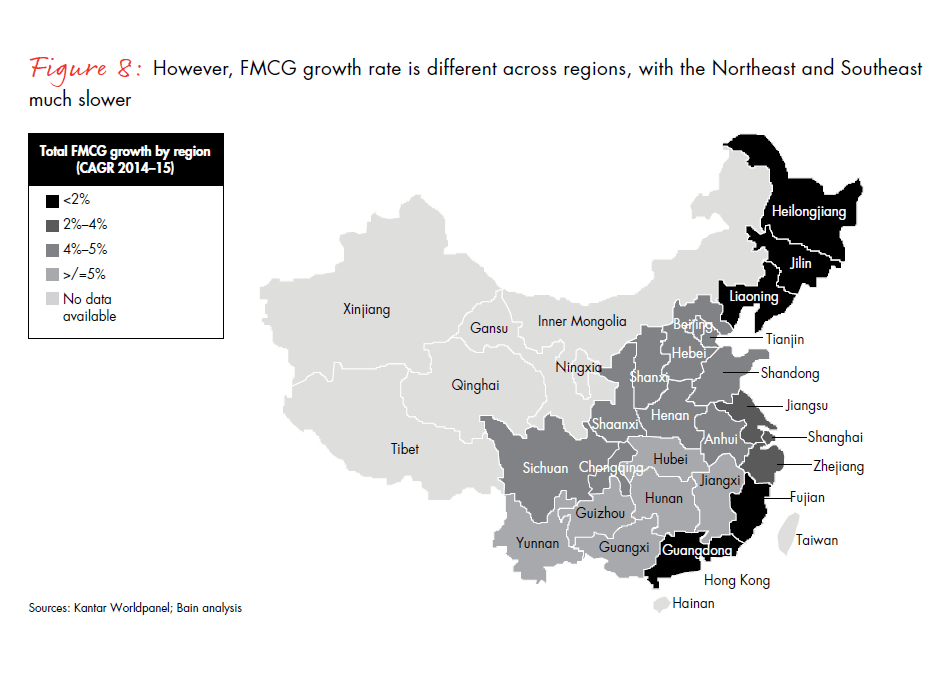
Two-speed penetration and premiumization among categories
For decades, FMCG companies strived to introduce their products to Chinese consumers by building vast distribution networks. They thought that this challenge was over. However, as we detail later in this report, important channel shifts are taking place. Brands now need to penetrate further in modern trade channels such as convenience stores while also finding cost-effective ways to grow in traditional trade. These efforts can help brands improve household penetration, defined as the percentage of households in a market buying a particular brand in a given year. The average penetration rate for the 26 categories we studied is 83%, with 10 categories exceeding 90%. During the years 2012 to 2015, only six of these categories gained penetration: yogurt, skin care, makeup, facial tissue, biscuits and chocolate.
But our research shows that penetration has plateaued in most product categories, and is even declining for some (see Figure 9). For example, categories perceived as less healthy or facing adverse demographic impact experienced a large drop, with instant noodles losing 5.6% in penetration and candy losing 4.5% from 2012 to 2015.
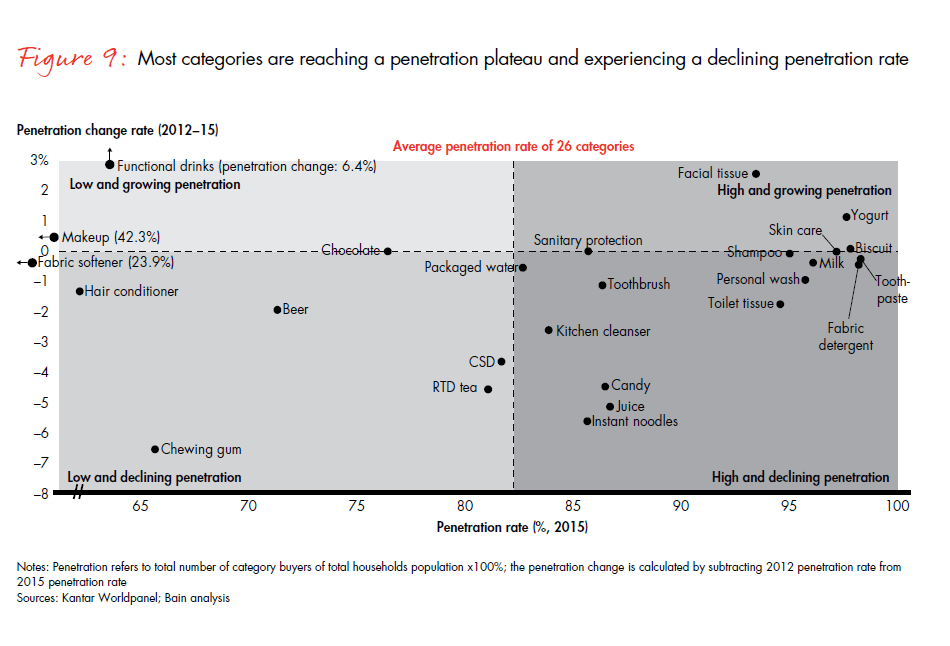
Declining penetration brings down volume growth (see Figure 10). That creates a new challenge for brands: With their distribution networks now in place, growth requires increasing the rate of sales at each point of distribution. Although the mission is clear, it isn’t always easy to fulfill. Marketers now need to drive frequency and transform their category into a regular consumption habit. However, frequency remains low in many categories in China. Only four categories among the 26 we studied have a frequency greater than 10 times per year: milk, infant formula, biscuits and yogurt. More important, frequency is not increasing because of larger package sizes and high promotion activities. Only four categories saw purchase frequency increase between 2012 and 2015: makeup, functional drinks, yogurt and chocolate.
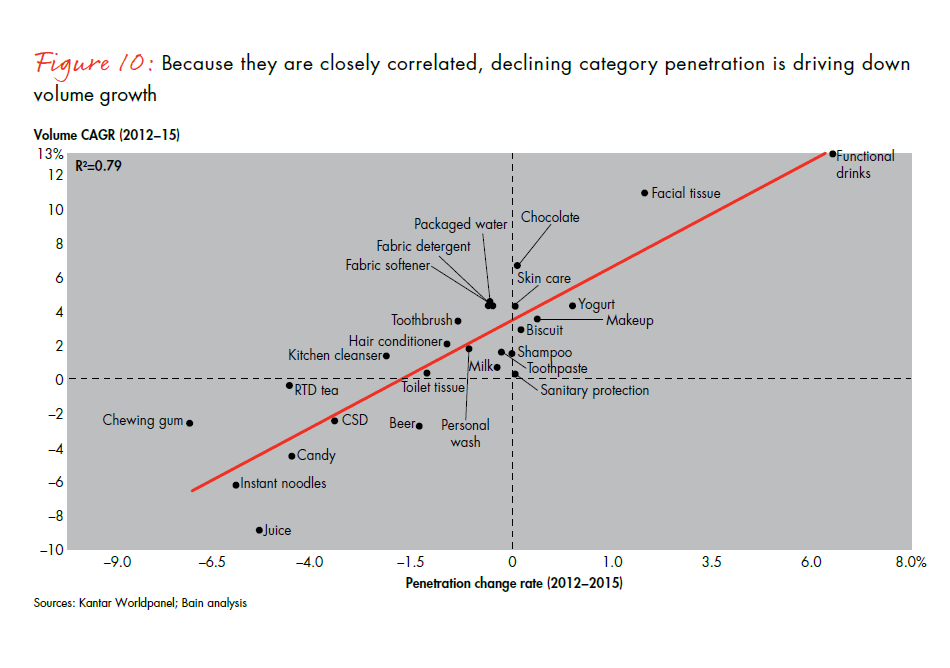
Therefore, most brands are turning to a proven approach for squeezing growth when penetration plateaus or declines: investing to offer premium products. Eighteen premiumization categories—those with average prices that rose faster than inflation—show flat or declining penetration since 2012 and growing premiumization (see Figure 11). Chinese consumers who can afford to do so are trading up in everything from packaged water, where premium brand Ganten Baisuishan is gaining share, to beer, where foreign brands like Budweiser continue to be popular.
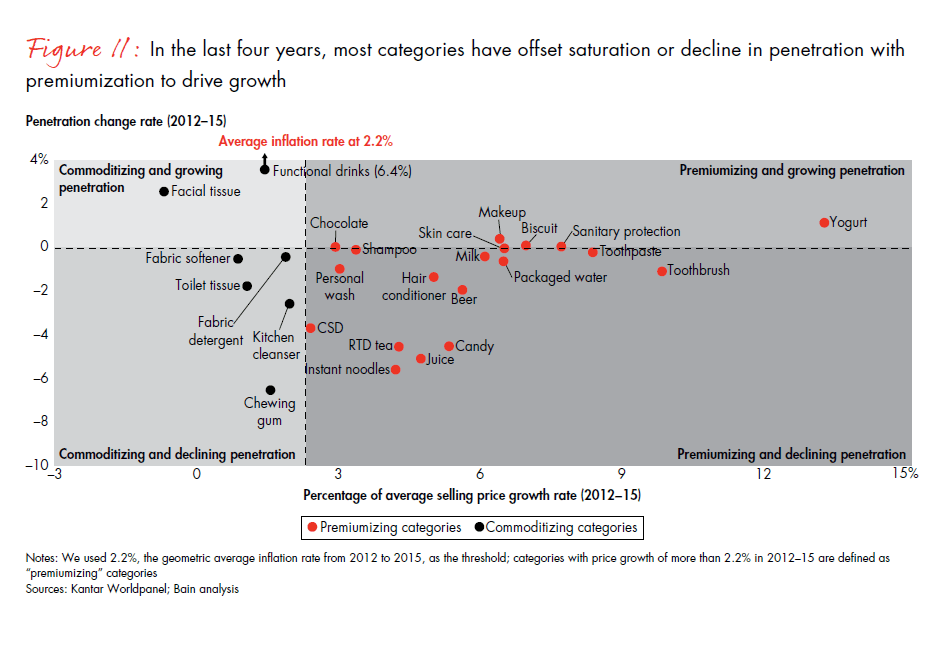
Among premiumization categories, only a few, such as yogurt and makeup, are still gaining ground. For example, makeup continues to boost penetration as Chinese women raise their beauty standards beyond skin care. Yogurt brands also have been particularly successful with this strategy. By introducing Ambriosial as a premium yogurt in ultra-high temperature (UHT) packaging, Yili has helped to maintain its high penetration even while commanding higher prices for the product, which appeals to the increasing number of Chinese consumers looking for healthier and safer food. Imported products in premiumization categories have either higher growth or higher share than other categories, as these products tend to be more expensive than local products (see Figure 12). This is especially true for packaged food, beverage and baby-related categories, because consumers view imported goods as safer than local products.
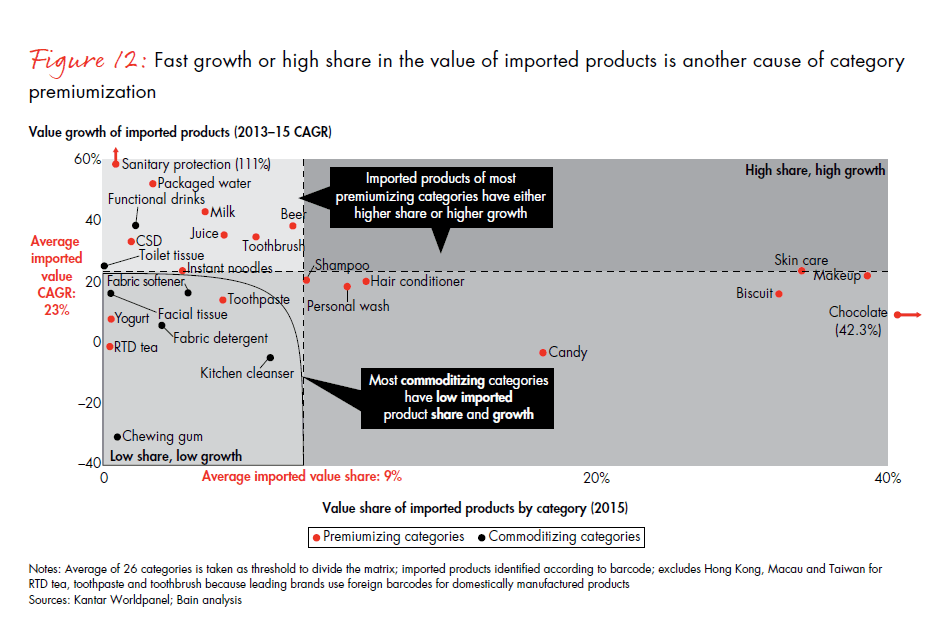
In commoditizing categories—those with price increases that lag inflation—the options are different. Here, brands strive to maintain penetration and value through promotions. Most commoditizing categories generated more of their value during promotions. This is especially true in home care categories. Consider that 33% of all toilet tissue was purchased on promotion, compared with a 20% average for all FMCG categories (see Figure 13).
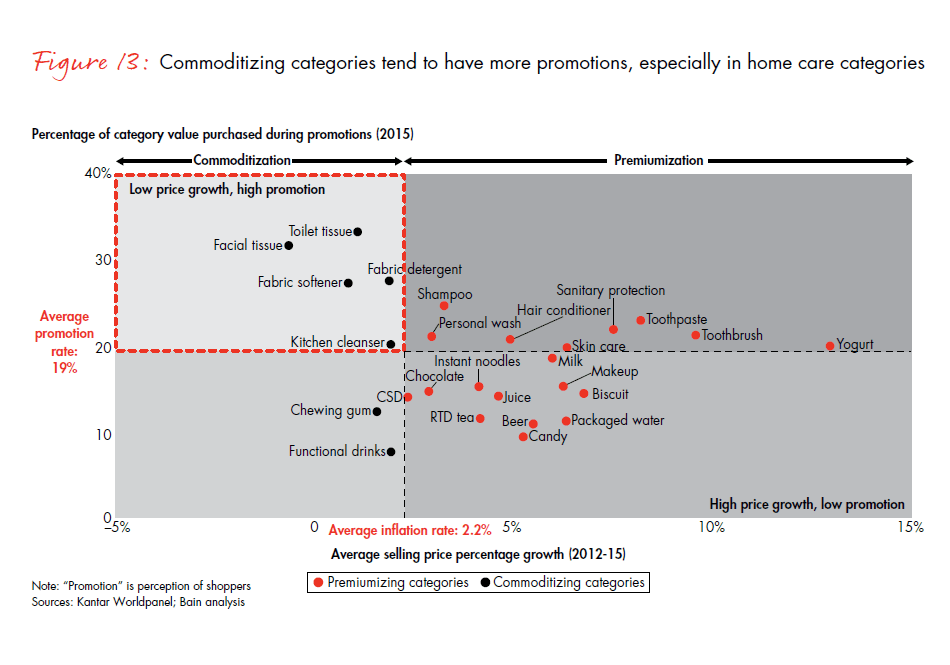
Two-speed growth in retail channels
Our fifth annual study of Chinese shopper behavior shows the ongoing evolution of the country’s retail landscape, with e-commerce and smaller formats like convenience stores expanding rapidly while the growth of supermarkets slows (see Figure 14). Convenience stores grew value share by 13.2% in 2015, while growth for the largest single category, super and mini stores, decelerated from 9.5% to 4.0%.
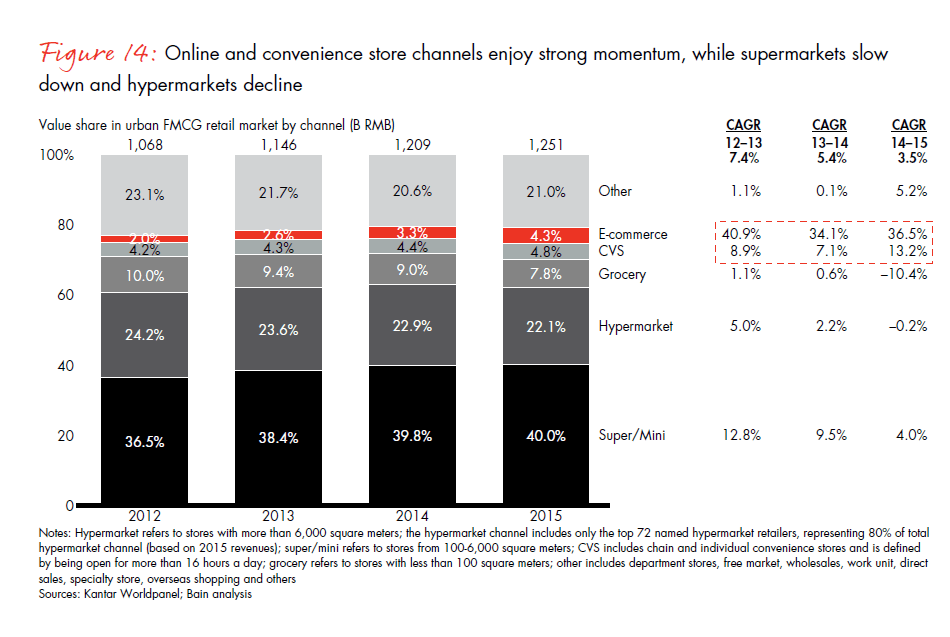
The hypermarkets that redefined China’s retailing environment over the past decade are now declining in sales, the victims of lower traffic and volume per household (see Figure 15). They registered their first drop, losing 0.2% value in the urban FMCG market, as traffic fell by 4.6% and volume per household sank by 4.7%.
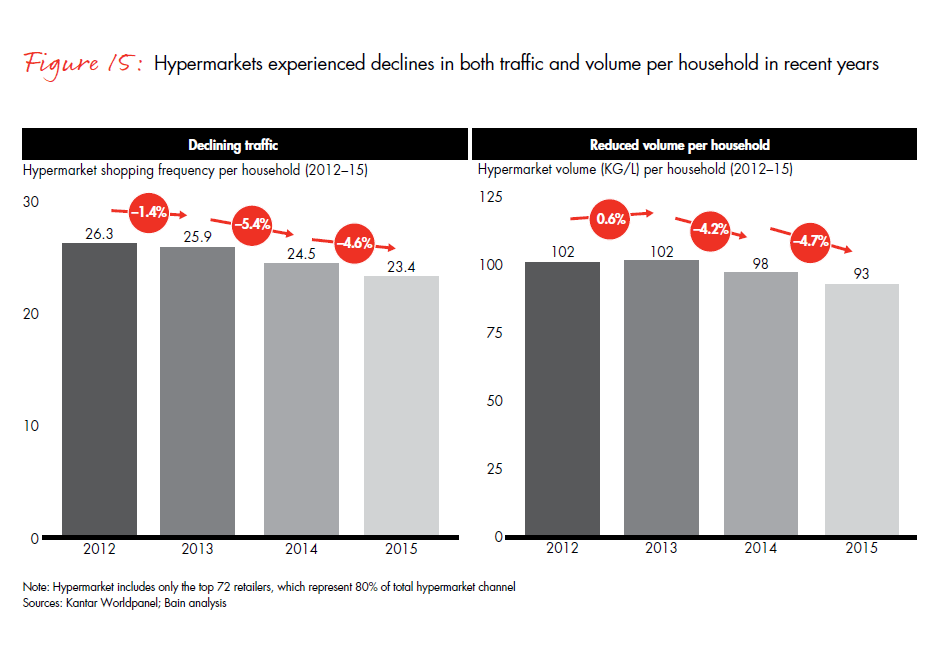
In the physical world of retailing, convenience stores clearly are gaining momentum, with 8.5% penetration growth across all city tiers. They appeal to cash-rich, time-poor urban consumers. Players like 7-Eleven and Quanshi convenience store are expanding rapidly, and retailers like Carrefour and Vanguard—which built their success in larger formats—are quickly catching up, offering Easy Carrefour and Legou Express stores.
No convenience matches that of online shopping, and China’s e-commerce marketplace continues to flourish, growing at an annual rate of more than 35% over the past four years and generating revenues of nearly RMB 4 trillion. China remains the world’s largest e-commerce market. Online penetration continues to increase at a swift pace, reaching 43% in 2015 from 25% in 2012.
Whereas the pace of growth for overall retail spending in China is evening out among city tiers, big differences are apparent in online shopper behavior. In Tier-1 cities, 8.4% of all FMCG purchases were made online. However, the smaller the city, the lower the portion of e-commerce purchasing. Shoppers in Tier-5 cities made only 2.7% of their FMCG purchases online, indicating high growth potential for brands (see Figure 16). Our research found that average selling prices in lower-tier cities are actually above those in higher-tier cities, as consumers focus their online spending on a few more expensive categories. For example, skin care accounted for 65% of all online purchases in Tier-5 cities, but only 34% in Tier-1 cities.
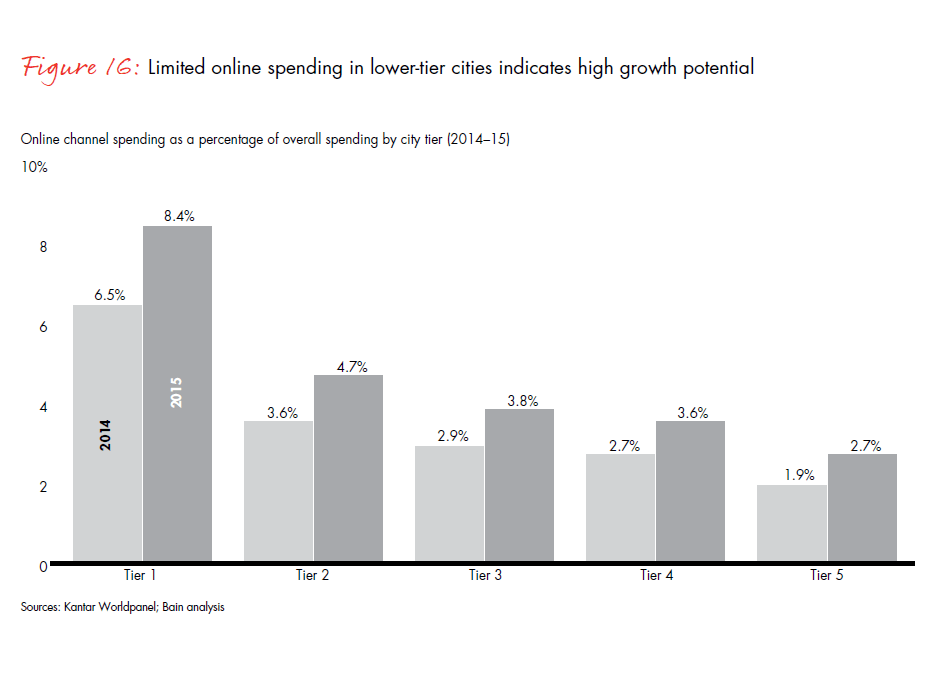
We identified three clusters of categories based on their digital penetration trajectory since 2012 (see Figures 17 and 18).
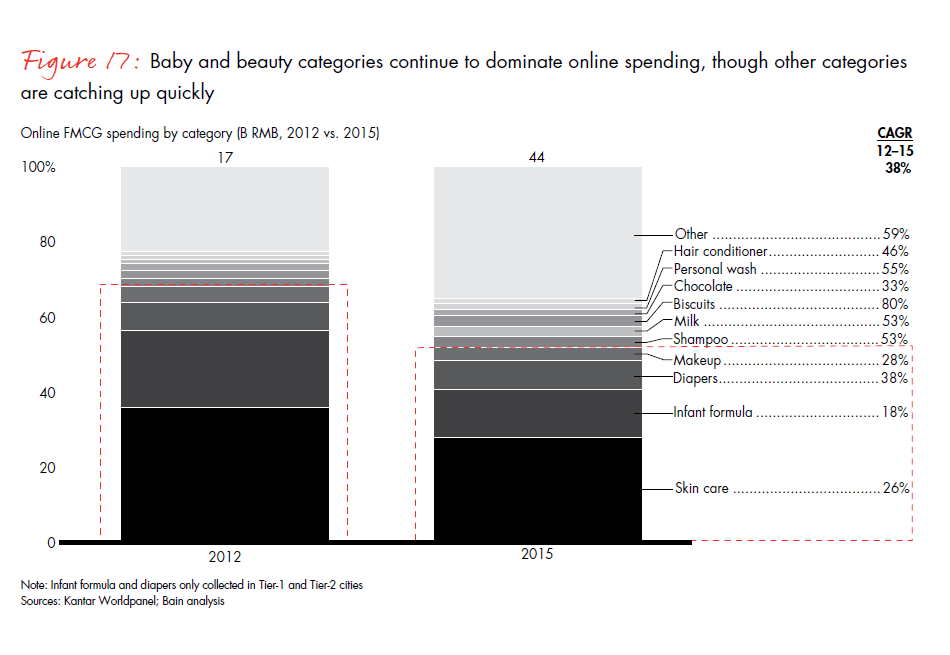
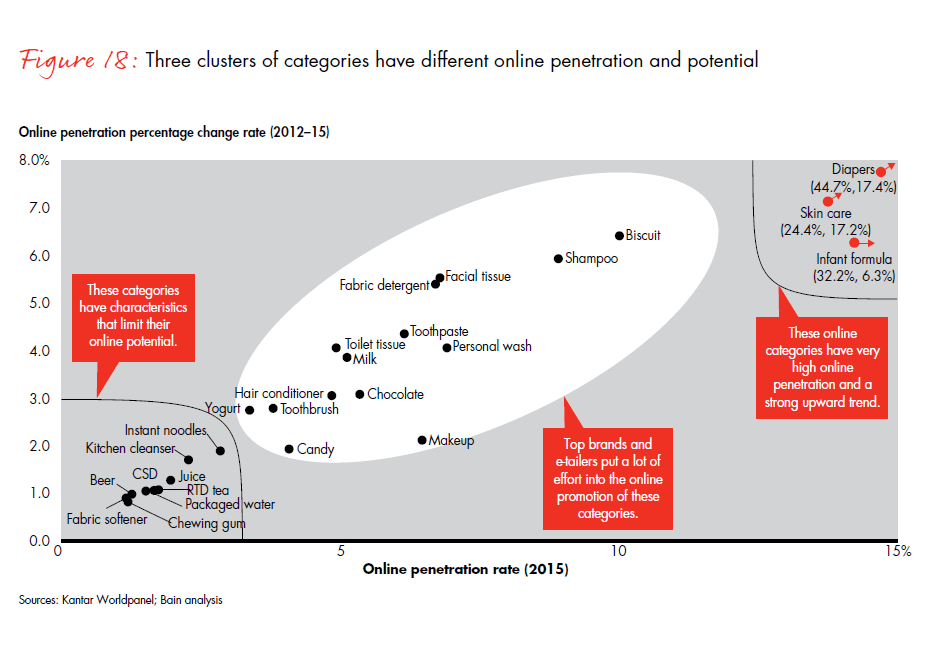
Baby- and beauty-related categories continue to dominate the e-commerce market because of high online penetration. Shoppers tend to buy these products online for access to a wider variety, including imported brands, which they view as being safer and better quality.
Chewing gum, fabric softener and beverages are among the categories with low online penetration—in fact, penetration has not grown significantly in the past four years. Among the reasons: Chewing gum tends to be an impulse purchase, beverages typically come with expensive last-mile delivery costs, and Chinese households do not buy fabric softener often.
Home care, some personal care and packaged food compose a third group of categories: those with mid-level penetration but high growth rates. E-retailers and brands are heavily promoting these categories to boost online penetration. For example, Procter & Gamble and Unilever are main brands of "Tmall Washing Days," a period in July meant to promote such categories as shampoos, hair conditioners and personal wash.
Two-speed growth for local and foreign brands
Local and foreign brands are advancing at different speeds in China, too. As in the four earlier studies, Chinese companies continued to gain share over their foreign competitors on an aggregate basis in most of the 26 categories we studied. In these categories, foreign brands’ sales shrank 1.4% in 2015. The sales of local brands grew by 7.8%, representing 109% of overall market growth (see Figure 19). Local brands gained share over foreign brands in 16 categories and across all city tiers, making their biggest wins in Tier-1 cities. Foreign brands gained share in only seven categories, and three categories had no change in share (see Figure 20).
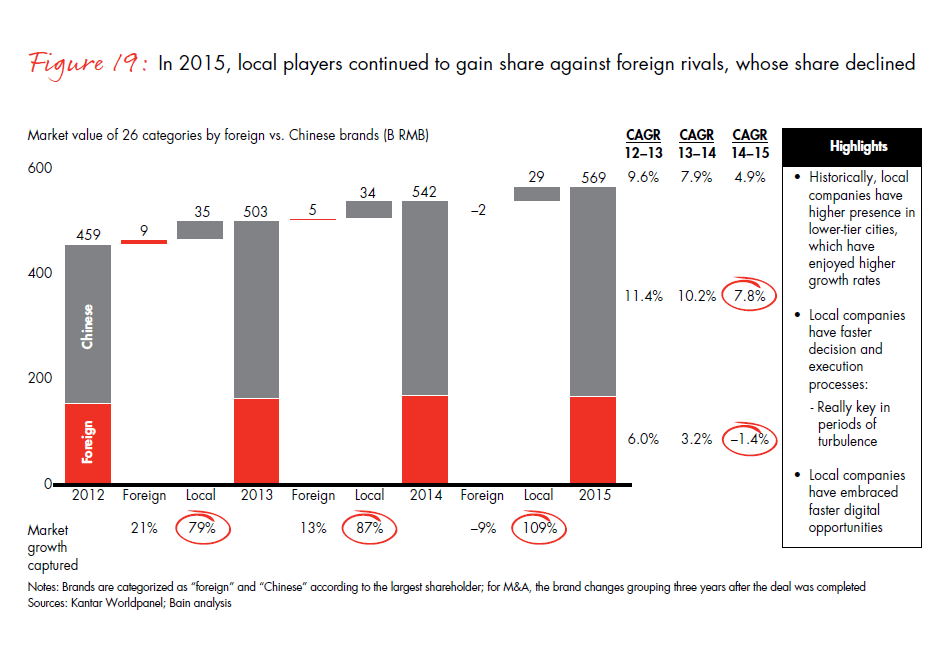
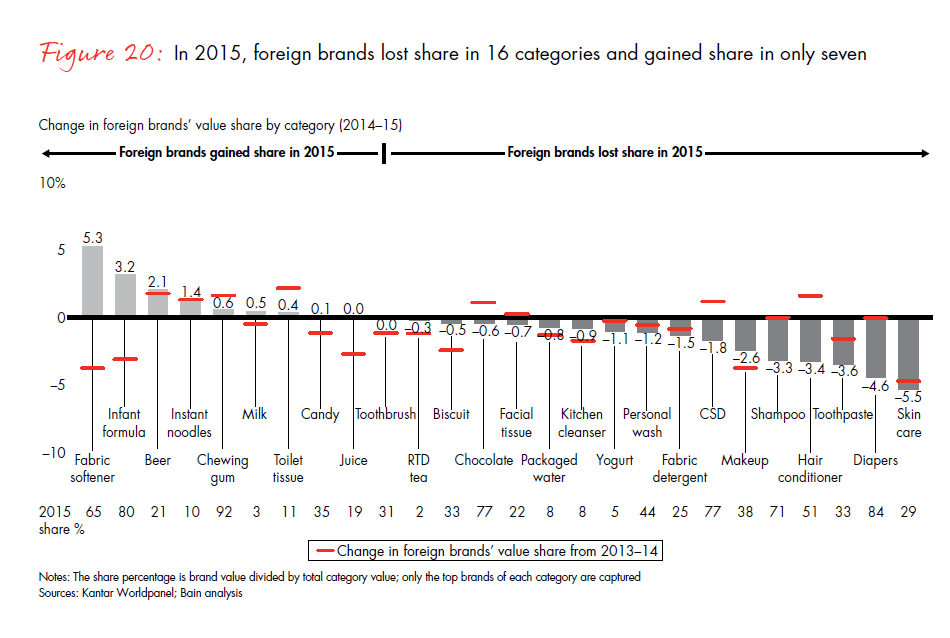
We should keep in mind that these numbers compare the aggregate share of foreign brands with the aggregate share of local brands across these categories. This does not mean that no individual foreign brand is gaining share; many foreign brands are doing so.
Chinese companies made the biggest advances in skin care, baby diapers, hair conditioners, toothpaste and shampoos. Foreign companies increased their share the most in fabric softener, infant formula, instant noodles and beer. In many cases, multinationals are gaining ground either through heavy marketing investments or as the result of food-safety concerns with local products.
Why are local brands performing so well? For one thing, they have a single-country-focused development process for new products and can quickly respond to what Chinese consumers want. For example, Shanghai Jahwa consistently uses its knowledge of Chinese herbal beauty therapy to win over consumers, staying ahead by frequently launching new SKUs.
Chinese companies also typically can make and execute decisions faster than their foreign counterparts. This allows them to adapt quickly to new trends with innovative products, and to find and pursue white-space opportunities—critical skills as FMCG sales decelerate. Seeyoung, a local shampoo brand that emerged in 2014, expanded its business last year by swiftly bringing silicone-free products to market, leaving foreign brands to follow its lead.
In addition, local companies are investing more in their brands, through both traditional media and digital or social media. Consider how Yili heavily promoted its sub-brands through multiple media channels: Guliduo, a Yili premium product, sponsored “Weirdo Talk” in 2015, a comedy debate talk show. Meanwhile, QQ Star, a Yili children’s milk brand, sponsored a reality TV show for fathers and kids, called “Where Are We Going, Dad?” It also initiated Weibo conversations about parenting and child development to maintain the brand popularity on social media. Based on the BrandZ top 100 most valuable Chinese brands report from Millward Brown, Yili’s brand value increased by 32% annually from 2012 to 2015.
Finally, local companies have embraced e-commerce faster than their foreign rivals: They diligently use omnichannel retailing to increase coverage. Seeyoung strengthened its presence in Tmall, JD.com and other e-commerce platforms, participating heavily in online promotions, while simultaneously building out its offline exposure. In snacking, Three Squirrels started four years ago as a pure online brand targeting the young generation with creative and fun cartoon-based advertising. It reached sales of RMB 2.5 billion in 2015, with ambitions to become the No. 1 snacking brand in China.
Companies and brands can win by:
Reviewing their cost structure and operating model to increase agility, speed in decision making and execution, and above all, the ability to embrace the ways that digital is disrupting their categories. Cost and operating models have not been a focus for companies in China so far, but as growth slows and digital disruption affects all elements of the value chain, companies have no choice but to embark on a digital transformation, the extent of which will depend on how much their category is disrupted.
Developing digital capabilities and mindsets specifically within their marketing and sales teams, and more broadly throughout all functions. Agility and speed of decisions and execution will become paramount, and brands need to adopt a "test, learn, adapt" mentality. Building digital capabilities in R&D, supply chain, marketing and sales is no longer optional.
Adapting their RTM model in line with the dramatic retail changes and the deterioration of distributors’ economics created by the overall market slowdown and online competition to focus on winning channels while investing selectively in others. Similar to retailers, distributors are under financial pressure. Many are driven out of business or decide to switch to more attractive ventures outside of FMCG brand distribution. As a result, some brands are losing points of distribution in China, and they need to find cost-effective ways to recapture those points.
Continuing efforts to boost penetration as the key to creating large brands, relying on digital activation as well as in-store activation. As mentioned in previous China Shopper Reports, three pillars are key to penetration: building on existing memory structures to get more shoppers to think about a particular brand as they shop; simplifying and rationalizing product portfolios to focus on critical "hero" SKUs that have the highest potential to win with shoppers; and perfecting in-store activation at the point of sale to ensure superior visibility and distinctiveness. Digital activation is now required, too, given that Chinese shoppers spend an average of three hours per day on digital media.
About the authors and acknowledgments
Bruno Lannes and Wei Yu are partners with Bain's Shanghai office. Jason Ding is a partner with Bain’s Beijing office. James Root is a partner with Bain’s Hong Kong office. Marcy Kou is CEO at Kantar Worldpanel Asia. Jason Yu is general manager at Kantar Worldpanel China.
Acknowledgments
This report is a joint effort between Bain & Company and Kantar Worldpanel. The authors extend gratitude to all who contributed to this report, in particular Marcia Mao and Roger Wu from Bain & Company and Rachel Lee, Tina Qin and Cathrine Chang from Kantar Worldpanel.
1 These 26 categories are a) packaged food: biscuits, chocolate, instant noodles, candy, chewing gum and infant formula; b) beverages: milk, yogurt, juice, beer, ready-to-drink (RTD) tea, carbonated soft drinks (CSD) and packaged water; c) personal care: skin care, shampoos, personal wash, toothpaste, makeup, hair conditioners, baby diapers and toothbrushes; and d) home care: toilet tissue, fabric detergent, facial tissue, kitchen cleanser and fabric softener.
2 Online penetration is defined as the number of people who bought online at least once per year divided by the total population.
